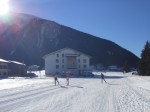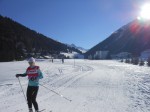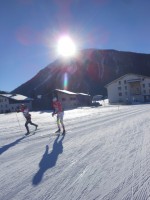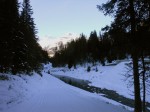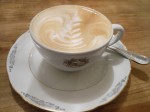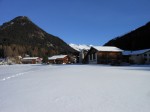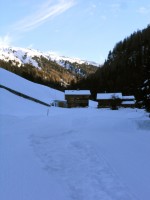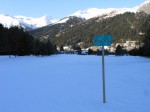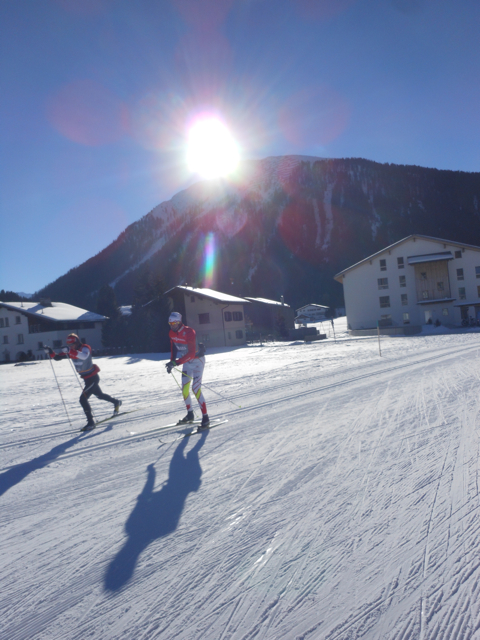
DAVOS, Switzerland – As the FIS World Cup cross country circuit descends on this small Swiss town, organizers are getting ready.
Perfectly groomed race trails and cold nights to keep the snow? Check.
Kilometers of fences and banners to line the courses? Check.
A cow pasture turned into a parking lot for the Russian and Scandinavian wax trucks? Check.
A temporary stadium for fans, booths above for announcers, and a giant tent billed as the “nordic lounge”? Check, check, check.
The one thing that’s missing is a healthy Dario Cologna, who is still sitting out with injury. The Swiss star, an Olympic gold medalist and World Cup champion, lives in Davos, and you might see him hobbling around even if he isn’t racing. With Cologna out, the Swiss will probably have to wait even longer for the first Swiss win at the venue since 1985, when Andi Grunenfelder won the 15 k. Even Cologna hasn’t been able to match that.
Davos and nearby Klosters are ski destinations, but the transformation is impressive as World Cup infrastructure for Saturday’s 15/30 k skate races and Sunday’s classic sprints is being built literally on the edge of town. Just a block from the Davos Dorf train station, on a residential street, trucks and personnel have moved in over the week (along with the help of the Swiss army) to create a bona fide spectator course. You don’t even have to take a bus or any transportation to get to the site from town. It’s in town. And a small town, at that – go just a couple hundred meters down the trails, and you’ll be in the midst of dairy farms, or maybe a golf course. With the exception of the World Cup loop, most of the trails pass houses and involve multiple road crossings – many of which stay snowy enough that you can just ski right across. Some lucky residents can even watch the races from the windows of their apartments.
Don’t let that fool you though. Spectators will fill the sunny stadium and fans will make their seats on the snowy hillside meadows surrounding the arena, filling the open space with happy noise (the forecast is for sun this weekend with highs of 1° C both days). But things change once you get in the woods. For one thing, it’s cold. That’s why Davos Nordic can roll out snow that they have saved all summer as early as November, along the trails heading up Fluelapass. It’s been sunny for a week in Davos, but once you head into the shady valleys, you get a serious chill. The Nations Group athletes might have a bit of an advantage as some of them have been skiing these trails for over a month.
And once you start along the Fluela trails, too, you hit the hills. The World Cup distance course winds back and forth a bit but primarily follows a small river that flows down from the pass. One particularly steep grade named in honor of Dario Cologna comes relatively early in the course – it might be a beast, but racers won’t get any real recovery for a few more minutes, as the climb simply becomes more gradual, V2 territory, before hitting the steeps again. Sitting at 1560 meters (over 5000 feet) of elevation, the long section of climbing becomes a real grind.
And they’re not done yet: dropping back into the stadium is no easy feat. The course features long, gradual sections where you can pick up speed but have to work for it, as well as one fast and sweeping corner that might be tricky to navigate when your legs are dying from that long climb.
Yet everyone seems to love Davos. Maybe it’s the sun, or the gentler non-race trails which skirt along flatter sections of the central valley. Maybe it’s the views of snow-capped mountains that rise over 1,000 meters higher all around the town – close enough to walk to (although maybe not in your clunky alpine ski boots). Davos is not a town but actually a collection of towns, starting from Davos Laret and Davos Wolfgang above the northern entrance to the long valley, running through Davos Dorf and Davos Platz, Frauenkirch, Davos Glaris, and finally to Davos Wiesen – a distance of almost 25 kilometers. There are about 12,000 permanent residents scattered through the area. Driving, you’d have to navigate a long tunnel just to reach the farthest hamlet in this archipelago of Swiss villages.
The main drag, though, runs from Davos Dorf to Davos Platz – that’s what you might consider town. Promenade is the street on the uphill side and Talstrasse on the downhill side, reaching two kilometers in each direction; the block in between the two streets forms the commercial backbone of town, while houses and apartment buildings are scattered up the hill towards the mountains. In Platz and Dorf you’ll find the grocery stores, bars, restaurants, and shops full of expensive Swiss goods. You’ll find, too, an art museum, a park, a conference center, and a pool and spa cutely named the “Eau La La”. Davos hosts the World Economic Forum every January, but the rest of the year caters to regular tourists, particularly those who like to hike, bike, and ski (two of the areas many alpine ski areas are accessible directly from town, the Parsenn area from Promenade in Davos Dorf and Jakobshorn from Talstrasse in Davos Platz). It is billed as the highest city in Europe and in the village of Monstein (between Davos Glaris and Davos Wiesen) you can visit the highest brewery in the world – Monsteiner, which makes tasty beers.
What else can you do for entertainment? Visit the Kaffee Klatsch, a coffeeshop beloved by locals and tourists alike, or check out the Egg, Chami, or Ex bars, among others, for some cheap-by-Swiss-standards beers and often music. Or you could go to Vaillant Arena (capacity: 7,700) to watch HC Davos play Swiss League hockey. The club most recently won championships in 2009 and 2011, and is arguably the biggest rival of attention against skiing – but their Zamboni is plastered with a Toko advertisement, so maybe skiing wins.
But on Saturday morning, few people will be in town. Kaffee Klatsch might be empty. Instead, everyone will fill the stadium for World Cup excitement. Here are some photos of the trails to get you prepped to watch from home.
Alex Kochon
Alex Kochon (alexkochon@gmail.com) is a former FasterSkier editor and roving reporter who never really lost touch with the nordic scene. A freelance writer, editor, and outdoor-loving mom of two, she lives in northeastern New York and enjoys adventuring in the Adirondacks. She shares her passion for sports and recreation as the co-founder of "Ride On! Mountain Bike Trail Guide" and a sales and content contributor at Curated.com. When she's not skiing or chasing her kids around, Alex assists authors as a production and marketing coordinator for iPub Global Connection.

